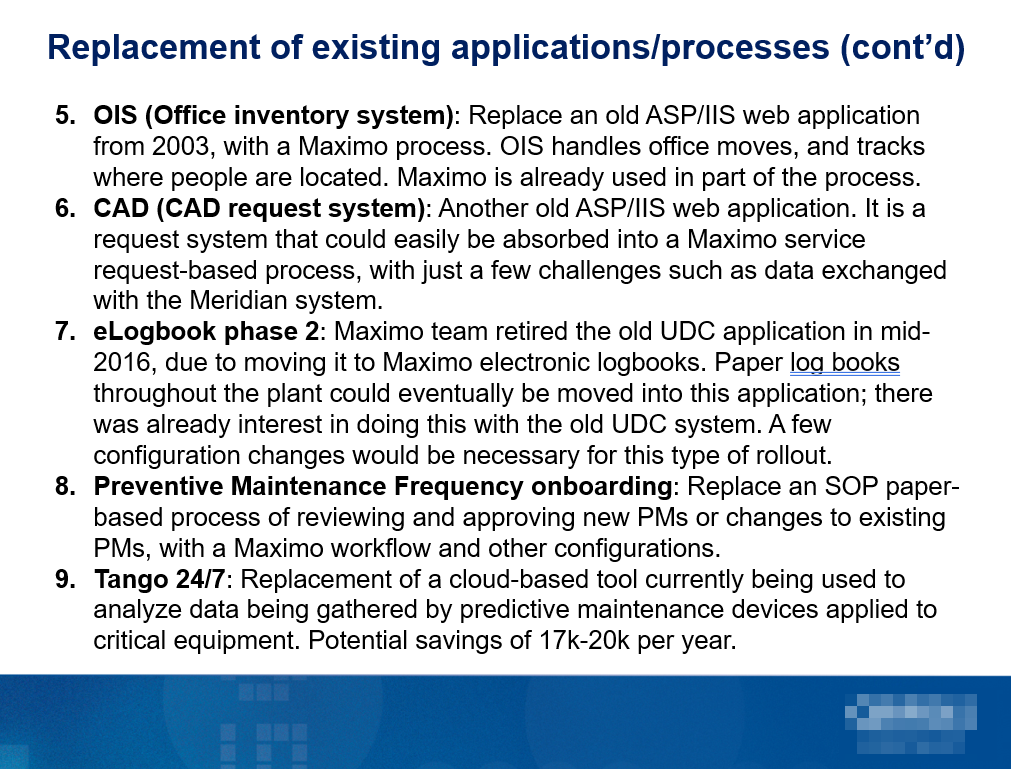Where Are We Headed? Maintaining a Maximo “Roadmap” (Part 2)
Hey again! Kevin Wertz, functional consultant at Interloc comin’ at ya again with part 2 of my post from a couple weeks ago. If you didn’t read Maintaining a Maximo Roadmap Part 1, I would encourage you to go back and take a look! I discussed the importance of having a governance meeting with management stakeholders and to create a roadmap with a 5-year outlook for all the types of work it takes to make a successful, growing, Maximo system that will continue to have value for your organization.
I showed a sample of the roadmap that we created at my former company and discussed the first two rows on the roadmap that cover basic support, IT demands, and more. But let me be honest…I don’t love support. What I love is IMPROVEMENT because a major reason I love what I do is that I love simplifying things, making my customers’ jobs easier, and saving money. So, rows 3 and 4 are where the rubber meets the road, as they say. So, let’s jump back in.
Row 3 of the roadmap is titled “Strategic / Value Added Improvement”. For example, going mobile with your Maximo system would be included in this section. Do you have a system that would make sense to integrate with Maximo such as SAP, Oracle financials, PeopleSoft etc. for purchasing? That effort would belong in this section as well. Or … maybe you have a module in Maximo that you haven’t implemented yet that would have value for your organization, such as inventory or contracts. Whatever it is, if it’s a value-added improvement to the system, present your vision to the governance team and see if you can get buy-in. Even if you place it 3 or 4 years into the future, get it on there! As you get closer and you realize you won’t have time for it, then just push it farther into the future. But no good idea should get discarded. If it has value, put it on the roadmap.

But row 4, “Replacement of existing applications or paper-based processes”, always contained my favorite work. This is where you really create happy customers and happy management. Replace a paper request form for new items to be added to inventory into a Maximo application and move all the signoffs into Maximo workflow, and your customers will love you and how you made their lives easier. Replace a separate system being used for utility logbooks by moving it into Maximo, and you just made IT management happy for saving software license and infrastructure costs, and you made utilities happier to have one less system they have to use. These are two examples of work we did at “Life Science Inc” that had high impact and really increased the value of the system. This is the kind of work I love! And by the way, these kinds of efforts can be much easier to calculate a payback period for ROI and get buy-in from management to work on.

Lastly, any good system has good documentation. On this version of the roadmap, this particular row reflected the documentation that a new company that bought our site a few years earlier wanted us to do for the largest organization using Maximo at that company. I recommend that you put any documentation efforts on a separate line such as this.

As I mentioned in part 1, we kept the roadmap itself to a single page. But that’s not to say that there weren’t other pages in the PowerPoint. The rest of our presentation included a write-up of every single item on the roadmap to give a summary about what each item is. The write-up sometimes even included initial thoughts on the business case for doing that item. In case anyone had a question on what an item on the roadmap meant or why we were proposing to do that item, they could refer to those ensuing pages.

Seems like a lot of work, right? Well, here’s the good news. Interloc would love to partner with you, help you create your roadmap, then help you execute it. We don’t want to be known just as that company that you only call for your initial implementations and upgrades. We want to partner with you through the whole lifecycle of your Maximo system.
For example, we’d love to visit your company and help you find opportunities to simplify your system landscape. Do you know that Maximo can replace existing HSE systems? What about utilities systems such as meter reading and logbooks? Yep. Do you know that Maximo can even do IT asset management? Or maybe Maximo can replace that home-grown Microsoft Access database where if that non-IT person in engineering who built it leaves the company, you’ll be left with no one to support it. With our vast knowledge of Maximo capabilities, we can really help you identify these opportunities and help you develop the ROI. The best IT projects that management will likely approve have a payback period of 3 years or less, and those are the ones we can help identify and get on your roadmap.
Maybe you know Maximo’s capabilities fairly well and you’ve already built a roadmap, but you don’t have the in-house resources like we had at my former company to get this work done. Interloc can do, and has done, work that fits into every one of these categories. Just a few examples:
Ongoing support: We’ve supported efforts to mass load data into the system from new buildings or companies purchased, or even simply performed the data migration from end to end.
Internal/Infrastructure: Of course, you probably already know that we excel at upgrades. MAS 8 is a hot topic these days, and we’ve done several of these upgrades already.
Strategic/Value Added Improvement: We have a great product called Mobile Informer that many companies have found to be an excellent fit for their organization. But if you prefer the IBM Maximo Mobile solution, we can help you with that too. Then there’s integrations: integrations with financial systems, for example, is a well-worn path for us.
Replacement of Existing Applications or Paper-based Processes: We’d love more of this type of work. As mentioned above, taking advantage of Maximo’s industry solutions and configurability can help you replace disparate systems, spreadsheets, and paper-based workflows, simplifying your IT landscape. This is where Maximo shines!
Documentation: We have helped many companies with all kinds of system documentation. From training materials, requirements docs, functional specifications, to test scripts, we can do it all.
I’m interested to find out: are you maintaining a roadmap for your Maximo system? How have you laid it out differently than the one I presented? Leave a comment below. Also let us know if we can help you get more value from your existing Maximo implementation by Contacting Us!
About Kevin Wertz
Kevin Wertz is a Maximo consultant who is new to Interloc as of April 2023. Before that he spent 23 years at a leading biotherapeutics manufacturer supporting CMMS/EAM systems, 16 of which he supported two Maximo systems full-time as-in-house IT support. He recently completed his first project with Interloc, a successful go-live of Maximo asset and work management functionality at a Canadian natural gas supplier. Throughout his career, Kevin has led multiple Maximo implementations and technical upgrades, demonstrating expertise in system optimization and development. Kevin is also an accomplished speaker, having presented at conferences such as MaximoWorld, IBM Pulse and InterConnect (now part of the IBM Think conference), and the former Life Sciences Maximo User Group (now part of the Manufacturing Maximo Users Group). Kevin loves to write and share his passion for Maximo.


